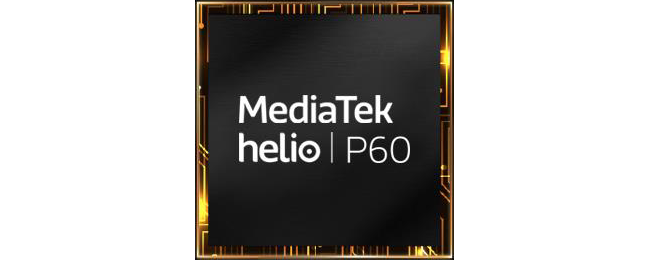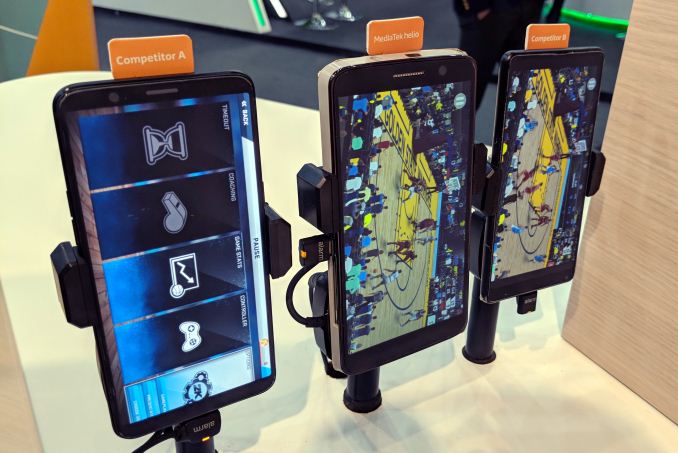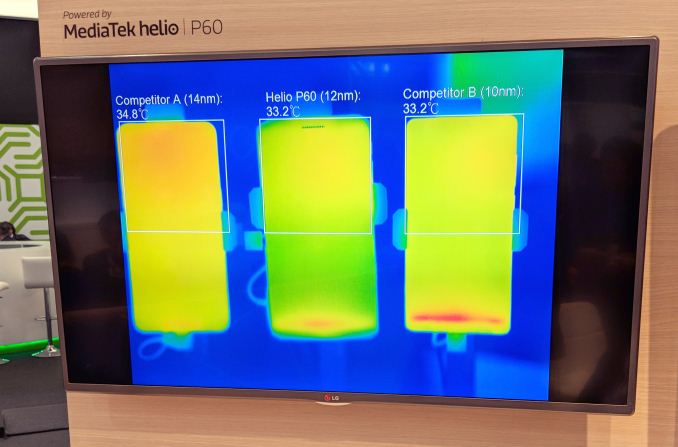MediaTek Announces New Premium Helio P60 SoC
by Andrei Frumusanu on March 1, 2018 9:30 AM EST- Posted in
- Smartphones
- Arm
- Mobile
- Trade Shows
- MediaTek
- Mali
- Helio
- MWC 2018
- P60
- A73
- A53
- ARM Cortex

BARCELONA, ESP – Earlier this week MediaTek announced a new entry in the Helio SoC line-up, the Helio P60. The P60 comes with a strategy change for MediaTek as the company is doubling down on the super-midrange “premium” category and expanding that range into multiple sub-tiers.
The strategy change comes from market and lack of success in the high-end Helio X series. Last year’s Helio X30 had only a few design wins and was relatively late to market. MediaTek seems to have had a string of bad luck with the X20 and X30 as both came on either problematic or very delayed manufacturing process nodes which lost them important design wins. As more vendors switch over to custom designs in the high-end and Qualcomm puts more pressure with competitive designs, MediaTek decided to put a hold on the X series for now and concentrate in the range where it is very successful, the P series.
The this new segmentation means that the P60 doesn’t position itself as direct successor to late last year’s P23 and P30 but rather as a tier above them, hence the naming scheme.
| MediaTek Current P-Series | |||
| SoC | Helio P23 | Helio P30 | Helio P60 |
| CPU | 4x Cortex A53 @ 2.3GHz 4x Cortex A53 @ 1.65GHz |
4x Cortex A53 @ 2.3GHz 4x Cortex A53 @ 1.65GHz |
4x Cortex A73 @ 2.0GHz 4x Cortex A53 @ 2.0GHz |
| GPU | Mali G71MP2 @ 770MHz | Mali G71MP2 @ 900MHz | Mali G72MP3 @ 800MHz |
| APU / NPU / AI Proc. / Neural IP | - | 2x 140GMACs | |
| Memory | 1x 32bit LPDDR3 @ 933MHz 2x 16bit LPDDR4X @1500MHz |
2x 16bit LPDDR4X @ 1600MHz | 1x 32bit LPDDR3 @ 933MHz 2x 16bit LPDDR4X @ 1800MHz |
| ISP/Camera | 1x 24MP or 2x 13MP | 1x 25 MP or 2x 16MP | 1x 32MP or 2x 20+16MP |
| Encode/ Decode |
2160p30 H.264 | 2160p30 H.264 & HEVC | 2160p30 H.264 & HEVC |
| Integrated Modem | Category 6 DL = 300Mbps 3x20MHz CA, 64-QAM UL = 50Mbps 64-QAM |
Category 7/13 DL = 300Mbps 3x20MHz CA, 64-QAM UL = 150Mbps 2x20MHz CA,64-QAM |
Category 7/13 DL = 300Mbps 3x20MHz CA, 64-QAM UL = 150Mbps 2x20MHz CA,64-QAM |
| Mfc. Process | 16FFC | 16FFC | 12FFC |
The P60 is the first SoC in the P-lineup to employ “big” microarchitecture cores as it uses 4x Cortex A73 cores at up to 2.0GHz – a significant performance boost in performance over the P23 and P30’s A53 cores. The efficiency cores are naturally still Cortex A53’s and they run at the same 2.0GHz frequency as the performance cluster.
On the GPU side we see an update in the IP as MediaTek in turn transitions from G71 to G72. The P60 uses a G72MP3 running at up to 800MHz and promises a 25% gaming efficiency boost (at up to 70% higher GPU performance).


Snapdragon 660 vs Helio P60 vs Snapdragon 835 Thermal Comparison @ MWC2018
The P60 is the first mobile SoC to come manufactured on TSMC’s new 12nm 12FFC process node. 12FFC is a shrink of 16FFC and uses the same tools – it’s a cost effective alternative to the more expensive 10FF process which requires quad-patterning. While 12FFC does not quite achieve the die size reduction that 10FF would, it’s extremely competitive in terms of power characteristics and reaches near the same efficiency. I asked MediaTek about the company process roadmap plan and they will focus exclusively on 12FFC for 2018 and have no plans for further 10nm silicon. The next generation will jump directly to 7nm in mid 2019 (after other vendors) when mass production will have reached mature and cost-effective levels.
The P60 is the first SoC to bring dedicated neural network accelerators into the mid-range. MediaTek’s denomination for such IP is APU (AI Processing Unit) so that’s yet another term added to the varied basket of abbreviations from different companies. MediaTek wouldn’t disclose the IP provider but say’s it’s a dual-core implementation offering 2x140GMACs. MediaTek will offer a custom software stack called NeuroPilot which will be compatible with Google’s NN API and frameworks such as TensorFlow, TF Lite, Caffe and Caffe2.
The modem subsystem remains the same as on the Helio P30 – it supports LTE up to Category 7 with 3x20MHz CA and 300Mbps download speeds and Category 13 with 2x20MHz CA for up to 150Mbps upload speeds.
The Helio P60 is in production now and we should see consumer smartphones with the chipset available starting early Q2 2018.










74 Comments
View All Comments
serendip - Saturday, March 3, 2018 - link
I'll grab my coat ;)Anyway, one final riposte - I'm not a fanboy of anything, I just want a fast and efficient *device* with long-term software updates. I don't care who the component vendors are.
Xiaomi + Qualcomm give me what I want despite both companies being utter ***holes in a lot of ways. Xiaomi are always late with kernel source releases and their bootloader policies are in sane whereas Qualcomm have stupid arbitrary restrictions on their chipset models, along with their predatory licensing practices. Qualcomm also screwed up the 845 but I'm happy that their midrange 660/670 designs are more efficient than the competition.
Xiaomi + Mediatek gives me slightly cheaper phones with less battery life and almost no third party ROM support, a compromise I'm not willing to make. At the end of the day, I'm a device user, not a semiconductor market analyst. My phone could be using a single core OMAP for all I care, as long as my usage requirements are met.
jjj - Sunday, March 4, 2018 - link
MTK went with 12nm and moderate enough clocks, memory not sure ,here we see 2x16bit but maybe that's not accurate- if true and coupled with the modem that's only Cat 7, this might be designed for a lower price point than what I was expecting.. They also got the new modem architecture, you can't bet on Qualcomm being lower power or higher perf or lower price.or anything.This space will be very crowded this year. It seems there will be P40 at some 12$, SD636 at some 15$, P60 likely somewhere between 15 and 18$, SD660 maybe above 20$, then P70, SD640 and SD670 - this last one might be priced high, not sure because not sure about specs, if it's aimed at 25-30$ or 40$.
The idea that Mediatek is cheaper is urban legend. Just like with any other product, the marketplace and costs will determine pricing. If anything, prices are good now because in the last couple of years Qualcomm has applied a lot more pressure in mid and low and that drove prices down.
Mediatrek had towards 50% margins in 2014 and that's solid, now they are at mid 30s because of the intense pricing pressure. Qualcomm's margins tanked too and they had to do rather large job cuts to sort out their financials, they aren't quite there yet- and all that despite having a monopoly in high end. Every solution is priced in line with what it offers, if they got a cost advantage vs the competition, they can apply more pressure, if they don't they take it easy. Qualcomm has a bit more leverage due to patents and scale but other than that,neither of them is some kind of bottom feeder that sells at very low margins.
ZolaIII - Sunday, March 4, 2018 - link
Well Xiaomi isn't that bad regarding releasing sources (all do released sources aren't that good) I would say they are average. Besides it's not a biggie one as they use unified kernel infrastructure (which is even bigger problem now regarding Treble requirements) along with most parts shared between different models so if their is a device earlier with same or similar SoC that source can be used (example Kenzo source used for Mi Max & Max Prime reworked). What they are really bad at it's updating source & working on it which brings question of security as you can't apply CVE's with out updating infrastructure to latest subversion (actually most of the times you can but it's hell of a work & it's much easier going the regular way). QC is a biggest peace of shit and last one standing (regarding open source). I am & developer and a guy who likes to play a lot with it especially when the scheduler & HMP scheduler. Jjj is a CEO & I won't say where.ZolaIII - Sunday, March 4, 2018 - link
It's not wrong (the S845 performance) most partly benchmarks use the Android favored instructions execution & most of those are only two instructions per clock so the third one most of the times isn't used at all. Take a look at the Web based PC Mark one's & you will see that then it's right on the Arm's projections as it uses the all 3 instructions per clock most of the times, you will also similar see decline in the A73 performance there compared to the A72. The RAM memory controller remain the exactly the same one as on S835. ARM messed up with shared L3 victim cache on per DinamIQ cluster that is actually rather bad and that in combination with half amount from maximum L2 QC employees is a result. ARMs bold claims how newly introduced per core unshared L2 & access to it is a big leap forward is very discussable. I mean sure as ARM puts it if those are only cores that will be used non shared exclusive access brings 2x performance & along with 2x of it that's equivalent to 4x more entries in same time frame which actually adds 5~9% (11~12% in extreme cases) towards performance. But let's take a look at reality; big cores are mostly used in a short bursts (for initing new processes & multiple worker's) or for running apps (with large numbers of workers) but then again in most cases especially on the Android platform (99%) only two of them. As it's possible (and desired) on the pre A75 core's SoC's that are octa big little one's it's possible to tune with a hotplug which cores remain always idle so that only the first one from the pair that shares L2 cache stay idle & with it have same exclusive access to the L2 which is also idle (besides even in those rare cases when all 4 are needed it will put them to use faster as it only needs to prepetch cache & init the core not initialise cache and core's. Having it like that along with amount of two core's idling also optimises the upmigration times on two cluster systems to optimal achievable. Now 2x larger L2 is costly and most if not all vendors won't go with it (QC didn't). So at the end old A72's A73's achieve benefit of exclusive access (in octa big little) & 2x larger L2 (when things are set up as described) while A75 won't because of the L2 size cut. I am concerned about S845 as the CPU clock's are far beyond sustainable level but as stated before that is becoming universal. At the end best design for A75/A55 DinamIQ on the mobile platform is 2x A75 (hopefully with ARMs referred 2x L2 size increase) & 4x A55's as in reality you really don't need more.One more thing as the things go FP operations are much better executed on small in order core's disregarding if its on VFP unit or NEON SIMD as performance penalty is only 22~30% while power usage is 3 to 5 times less when small core's are used as FP tasks scale good in SMP (while integer one's don't) this future more enhances the small in order core usage benefits in FP tasks...
Plumplum - Saturday, March 10, 2018 - link
Mediatek doesn't use standard Big.LITTLE but CorepilotCorepilot is something between Big.LITTLE ans DynamIq
Coherent cache is allready include in Corepilot since Helio X20 (in addition of allowing more than 2 clusters)
We don't know Many things about SD700 serie and if they will really use a rebranded cortex A75 or A73.
Qualcomm only tell about IA improvement (that is allready include in P60)
About A75, I think it will be as stable as A72...A72 is ok even on 20nm process
Plumplum - Saturday, March 10, 2018 - link
P60 is Snapdragon 660 competitor...even the name shows itKryo 260 is mostly a rebranded cortex A73...nearly exactly the same performances
SoC lover - Friday, March 2, 2018 - link
For my opinion i 100% hate Mali GPU 1.it lags2.it heats
3.not worth
RaduR - Saturday, March 3, 2018 - link
Why they are not using Imagination GPU I can't understand. Imagination is desperate to get a new design win as they almost went under after Apple ditched them .They had MIPS did nothing with it why they are not present in these CPUs I can understand. The only way MTK can beat QC is with Imagination. Somehow both companies need each other
jjj - Sunday, March 4, 2018 - link
Andrei, are you 100% certain it's 2x 16bit LPDDR4X @ 1800MHz. I know they list dual channel but maybe it's semantics and they mean 2x32.If 2x16, then this is designed to be rather cheap and maybe there is no P40?
ZolaIII - Sunday, March 4, 2018 - link
Think memory controller remains the same as previously on P series which narrow it down to 2x 16 bit LPXDDR 4 up to 2.3 GHz (but hardly anyone will put top of the pop ones especially in memory shortage crises so 1.33 GHz modules is what we will be seeing) & 1x 32 bit LPDDR 3.